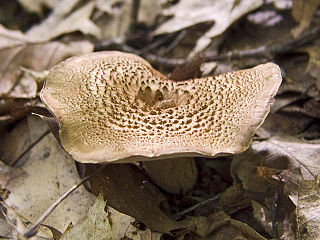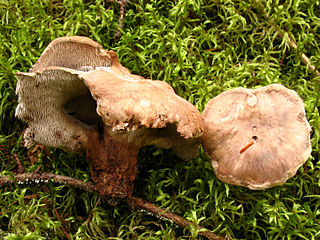
Hydnellum peckii is a fungus in the genus Hydnellum of the family Bankeraceae. It is a hydnoid species, producing spores on the surface of vertical spines or tooth-like projections that hang from the undersurface of the fruit bodies. It is found in North America, Europe, and was recently discovered in Iran (2008) and Korea (2010). Hydnellum peckii is a mycorrhizal species, and forms mutually beneficial relationships with a variety of coniferous trees, growing on the ground singly, scattered, or in fused masses.

Hydnellum is a genus of tooth fungi in the family Bankeraceae. Widely distributed in the Northern Hemisphere, the genus contains around 40 species. The fruitbodies of its members grow by slowly enveloping nearby bits of grass and vegetation. There is great variability in the form of Hydnellum fruitbodies, which are greatly influenced by environmental conditions such as rainfall and humidity, drying winds, and temperature. They are too tough and woody to eat comfortably. Several species have become the focus of increasing conservation concern following widespread declines in abundance.

Phellodon is a genus of tooth fungi in the family Bankeraceae. Species have small- to medium-sized fruitbodies with white spines on the underside from which spores are released. All Phellodon have a short stalk or stipe, and so the genus falls into the group known as stipitate hydnoid fungi. The tough and leathery flesh usually has a pleasant, fragrant odor, and develops a cork-like texture when dry. Neighboring fruitbodies can fuse, sometimes producing large mats of joined caps. Phellodon species produce a white spore print, while the individual spores are roughly spherical to ellipsoid in shape, with spiny surfaces.

Sarcodon is a genus of fungi in the family Bankeraceae, which is part of the order Thelephorales known for its almost universal ectomycorrhizal life style. The genus owes its name to the presence of teeth-like spines on the hymenophore, it is derived from ancient Greek; sarco = flesh and odon = tooth. This is why they are commonly called "tooth fungi", or "Hydnoid fungi".

Hydnellum aurantiacum is an inedible fungus, commonly known as the orange spine or orange Hydnellum for its reddish orange or rusty red colored fruit bodies. Like other tooth fungi, it bears a layer of spines rather than gills on the underside of the cap. Due to substantial declines in sightings, this species is listed as critically endangered in the United Kingdom.

The hydnoid fungi are a group of fungi in the Basidiomycota with basidiocarps producing spores on pendant, tooth-like or spine-like projections. They are colloquially called tooth fungi. Originally such fungi were referred to the genus Hydnum, but it is now known that not all hydnoid species are closely related.

Hydnellum ferrugineum, commonly known as the mealy tooth or the reddish-brown corky spine fungus, is a species of tooth fungus in the family Bankeraceae. A widely distributed species, it is found in north Africa, Asia, Europe, and North America. The fungus fruits on the ground singly or in clusters in conifer forest, usually in poor or sandy soil. Fruit bodies are somewhat top-shaped, measuring 3–10 cm (1–4 in) in diameter. Their velvety surfaces, initially white to pink, sometimes exude drops of red liquid. The lower surface of the fruit body features white to reddish-brown spines up to 6 mm long. Mature fruit bodies become dark reddish brown in color, and are then difficult to distinguish from other similar Hydnellum species. H. ferrugineum forms a mat of mycelia in the humus and upper soil where it grows. The presence of the fungus changes the characteristics of the soil, making it more podzolized.

Phellodon tomentosus, commonly known as the zoned cork hydnum, is a species of tooth fungus in the family Bankeraceae. First described as Hydnum tomentosum by Carl Linnaeus in 1753, it was transferred to the genus Phellodon by Howard James Banker in 1906. It is found in Asia, Europe, and North America.

Hydnellum fuscoindicum is a species of tooth fungus in the genus Hydnellum. It is found in the Pacific Northwest in moss around western hemlocks. It produces fruit bodies with a violet-black cap, violet flesh, and violet spines on the cap underside. The odor and taste are very farinaceous. The fungus was first described by Kenneth A. Harrison in 1964 as a species of Hydnum, then transferred to Sarcodon in 1967 by Rudolph Arnold Maas Geesteranus. He placed this species in section Violacei of Sarcodon, along with H. fuligineoviolaceum and H. joeides.

Hydnellum scrobiculatum, commonly known as the ridged tooth, is a tooth fungus in the family Bankeraceae. Widely distributed in the Northern Hemisphere, it is found in Asia, Europe, and North America.
Hydnellum conigenum, commonly known as the funnel hydnum, is a species of tooth fungus in the family Bankeraceae found in North America. It was first described in 1903 by American mycologist Charles Horton Peck from collections made growing on fallen cones of ponderosa pine, near the base of the Moscow Mountains. Peck thought it was similar to H. aurantiacum, differing in its smaller size, more slender stipe, non-zoned flesh, more even cap, and somewhat unusual substrate. Howard James Banker transferred it to the genus Hydnellum in 1906. Its range extends from New Mexico to British Columbia and the Great Lakes region, where it grows in coniferous forests.

Phellodon niger, commonly known as the black tooth, is a species of tooth fungus in the family Bankeraceae, and the type species of the genus Phellodon. It was originally described by Elias Magnus Fries in 1815 as a species of Hydnum. Petter Karsten included it as one of the original three species when he circumscribed Phellodon in 1881. The fungus is found in Europe and North America, although molecular studies suggest that the North American populations represent a similar but genetically distinct species.

Hydnellum underwoodii is an inedible species of tooth fungus in the family Bankeraceae. Found in North America, it was described as new to science in 1906 by American mycologist Howard James Banker. Its reddish-brown, convex to flattened cap measures 5–14 cm (2.0–5.5 in) in diameter. Reddish-brown, partially erect scales adorn the cap surface. Spines on the cap underside are 1–3 mm long; they are initially white, becoming brown with grayish tips in age. The oval to spherical spores are 6–7.5 by 5.5–6.5 µm. The fungus fruits singly or scattered, on the ground in coniferous forests.

Sarcodon stereosarcinon is a species of tooth fungus in the family Bankeraceae. Found in North America, it was described as new to science in 1940 by mycologist Lewis Edgar Wehmeyer, who found the original collections in Nova Scotia, Canada.

Sarcodon rimosus, commonly known as the cracked hydnum, is a species of tooth fungus in the family Bankeraceae. Found in the Pacific Northwest region of North America, it was described as new to science in 1964 by mycologist Kenneth A. Harrison, who initially called it Hydnum rimosum. He transferred it to the genus Sarcodon in 1984. Fruit bodies of S. rimosum have convex to somewhat depressed caps that are 4–12 cm (1.6–4.7 in) in diameter. The surface becomes scaly in age, often developing conspicuous cracks and fissures. It is brown with violet tints. The flesh lacks any significant taste and odor. Underneath the cap cuticle, the flesh turns a bluish-green color when tested with a solution of potassium hydroxide. The brownish-pinks spines on the cap underside are typically 2.5–7 mm long, extending decurrently on the stipe. Spores are roughly spherical with fine warts on the surface, and measure 5–6.5 by 4.5–5 µm. The hyphae do not have clamp connections.

Sarcodon calvatus is a species of tooth fungus in the family Bankeraceae. It was described as new to science in 1964 by mycologist Kenneth A. Harrison, who initially called it Hydnum calvatum. He transferred it to the genus Sarcodon in 1984. It is found in North America.

Hydnellum joeides is a species of tooth fungus in the family Bankeraceae.

Sarcodon thwaitesii is a species of tooth fungus in the family Bankeraceae. It is found in Asia, Europe, and New Zealand, where it fruits on the ground in mixed forest.
Sarcodon scabripes is a species of fungus in the family Bankeraceae found in Asia, Europe, and North America. It was originally described in 1897 as Hydnum scabripes by Charles Horton Peck. Howard James Banker transferred it to the genus Sarcodon in 1906. The fungus makes fruit bodies with a drab gray to flesh-colored cap, and flesh that is white. In addition to the United States, where it was first documented, S. scabripes has been reported from Japan and the Sverdlovsk Oblast region of Russia.

Hydnellum versipelle is a species of tooth fungus in the family Bankeraceae. It was originally described by Elias Fries in 1861 as Hydnum versipelle. Taisiya Lvovna Nikolayeva transferred it to the genus Sarcodon in 1961. Hydnum crassum, published by Kenneth A. Harrison in 1961, is a synonym. The species is found in Europe and North America.
















